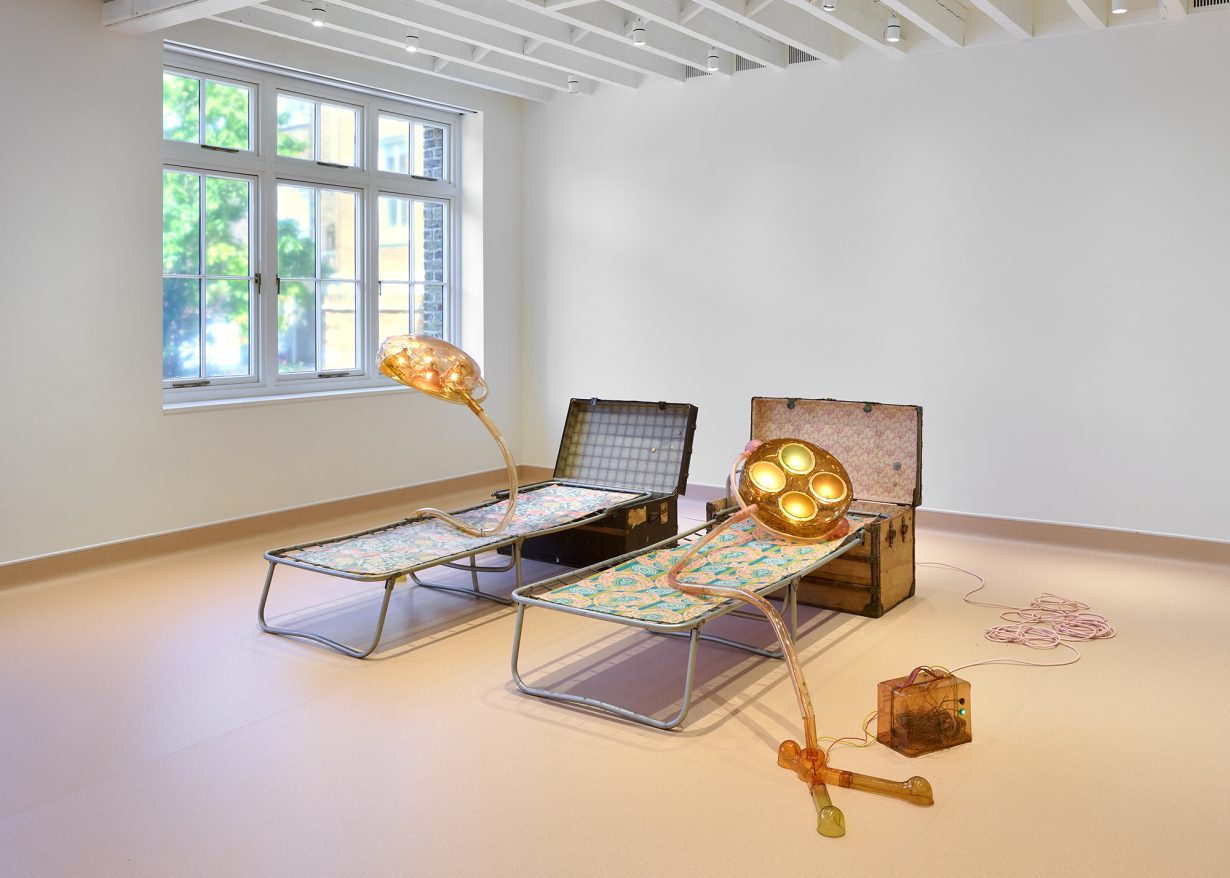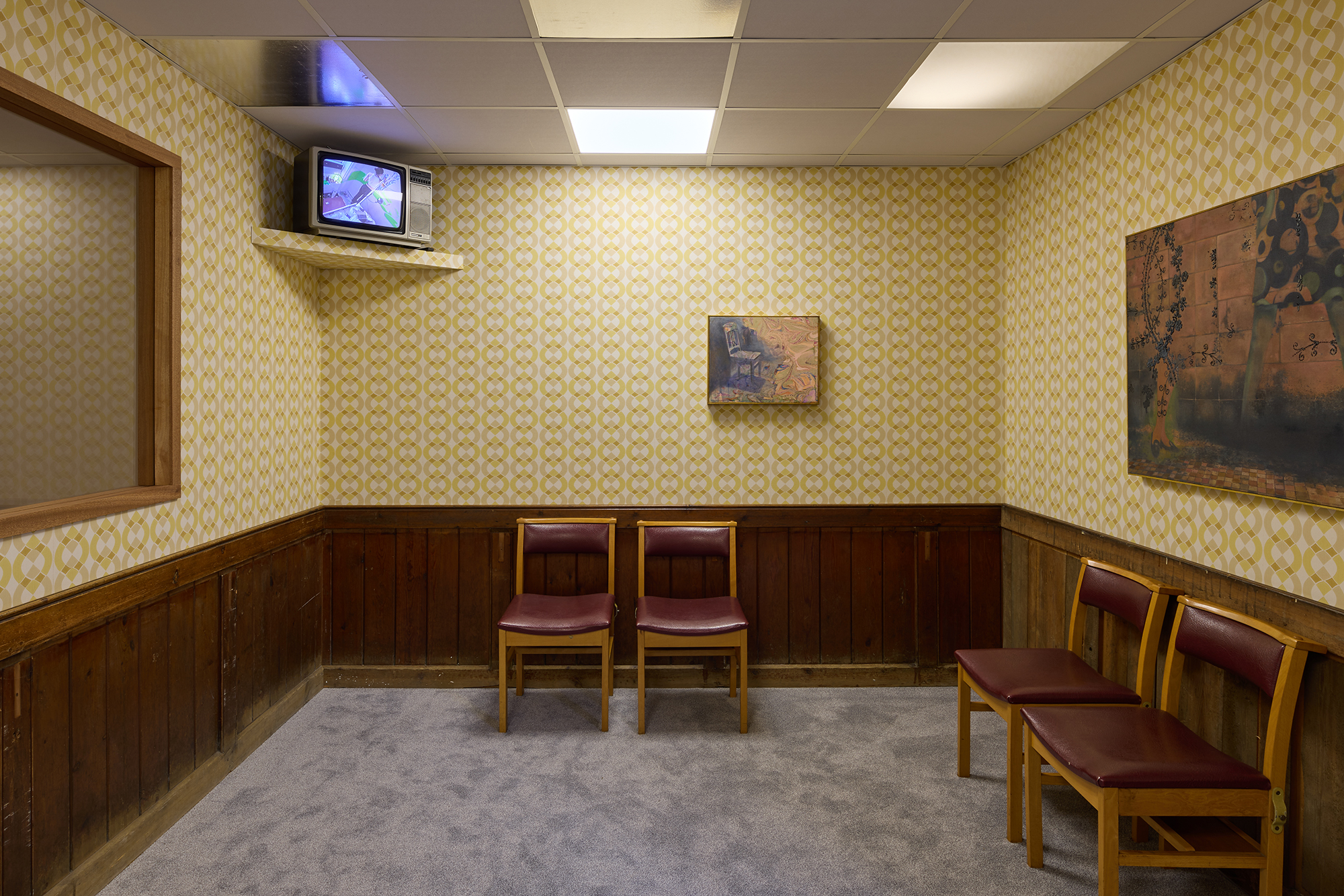Gaaaaaaasp at The Perimeter, London wonders how we could ever feel comfortable in this world
Taking your shoes off at the entrance of the gallery, as you are asked to when you walk through the door, is just about the only thing that makes you feel at home in this exhibition. The show unfolds over all four floors of The Perimeter’s reconverted warehouse space that is split into rooms of varying sizes and ceiling heights, and visible but inaccessible nooks. The artist has reupholstered each room with custom wallpaper and floor coverings, giving them a distinctly retro vibe. The two largest spaces become immersive installations, one turned into an observation room and the other a hospital interior. Within them, sculptural objects appear to stand in for women’s bodies, while actual painted or filmed portrayals of women disappear flatly into the decor.
The ‘observation room’ on the ground floor introduces a sense of entrapment and voyeurism. Half of the space is decorated with a stuffy and outdated gradient of tans – with dark wood panelling, yellowed wallpaper, grey carpet, lowered tiled ceilings and burgundy chairs pushed against the wall. It might as well be accompanied by the smell of cold tobacco. On the walls, three paintings act as decorative elements: women’s legs, women’s legs, four-legged chair, all shrouded – indiscriminately – by a layer of painted swirls. As in the majority of the paintings in the exhibition, women’s bodies, or fragments of them, dressed in 1960s fashion and rendered in grisaille, fade into ornamental and at times psychedelic patterns that mirror the artist’s wallpapers and the fabric that coats her sculptures. These patterns create a suffocating and disorienting atmosphere as they thread through the exhibition. Cropping up like the shimmering colours reflecting off a soap bubble, they give the viewer the impression of being only half conscious – as though seeing stars – or trapped under the metaphorical bell jar.

Meanwhile, the other half of the room is sealed off by a literal glass pane. On the far side of that glass, five wooden poles stretch out and curl back onto themselves between the ceiling and the maroon-carpeted floors (…Globus/Womb #1–5, all works 2025). Within their curlicued bodies, round stained-glass windows in faded red, green and blue depict tree branches or venous systems. They have the transparent quality of X-ray film, and as the artificial overhead lighting shines through them, they project dendritic shadows onto the wall behind. The viewer watches as if from behind a one-way mirror. A creeping feeling of surveillance is emphasised by Cam 2017/2018, which plays on an old television set propped on a high shelf in a corner. The video shows footage of the artist working in her studio, seemingly unaware of the camera that watches her from slightly above head height, at the same angle one would expect to see via CCTV.
One floor above, two loosely anthropomorphised lamps blown up to human proportions slouch on camp beds unfolded from wooden travel trunks (Sad Instrument and No Such Patient). Their backs are turned away from one another as their large heads topple and their lanky deflated bodies half hang off the beds and onto the pink vinyl-clad floors. The lamps’ wiring, or sedating IV drip, is visible through their translucent beige plastic bodies. As are the clunky bolts used to screw them into place, violently ripping into their shell to fasten them to the beds. Mirroring this evisceration, St. Tabitha, on the top floor, is made of bouncing balls attempting to leap out of an open chest only to find themselves halted in their flight, skewered and fixed to their base by rough iron rods. The variously tortured and more or less anthropomorphic objects that occupy the space are the emotional crux of the exhibition. Viscerally relatable, they act as foils to the distant and anachronistic figures of women, kept behind screens, that haunt the walls. Between them is a common theme of bodily dispossession that creates a strong sense of malaise. How can women ever be at ease, Metcalf seems to ask, when even within spaces of treatment and care they have been ceaselessly objectified.
Gaaaaaaasp at The Perimeter, London, through 25 July
From the September 2025 issue of ArtReview – get your copy.
